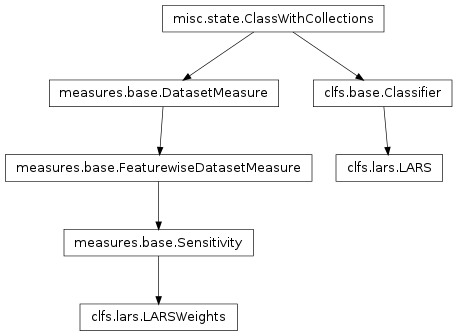 |
Multivariate Pattern Analysis in Python |
 |
Multivariate Pattern Analysis in Python |
Inheritance diagram for mvpa.clfs.lars:

Least angle regression (LARS) classifier.
Bases: mvpa.clfs.base.Classifier
Least angle regression (LARS) Classifier.
LARS is the model selection algorithm from:
Bradley Efron, Trevor Hastie, Iain Johnstone and Robert Tibshirani, Least Angle Regression Annals of Statistics (with discussion) (2004) 32(2), 407-499. A new method for variable subset selection, with the lasso and ‘epsilon’ forward stagewise methods as special cases.
Similar to SMLR, it performs a feature selection while performing classification, but instead of starting with all features, it starts with none and adds them in, which is similar to boosting.
This classifier behaves more like a ridge regression in that it returns prediction values and it treats the training labels as continuous.
In the true nature of the PyMVPA framework, this algorithm is actually implemented in R by Trevor Hastie and wrapped via RPy. To make use of LARS, you must have R and RPy installed as well as the LARS contributed package. You can install the R and RPy with the following command on Debian-based machines:
sudo aptitude install python-rpy python-rpy-doc r-base-dev
You can then install the LARS package by running R as root and calling:
install.packages()
Note
Available state variables:
(States enabled by default are listed with +)
Initialize LARS.
See the help in R for further details on the following parameters:
| Parameters: |
|
|---|
Returns a sensitivity analyzer for LARS.
Bases: mvpa.measures.base.Sensitivity
SensitivityAnalyzer that reports the weights LARS trained on a given Dataset.
Note
Available state variables:
(States enabled by default are listed with +)
Initialize the analyzer with the classifier it shall use.
| Parameters: |
|
|---|